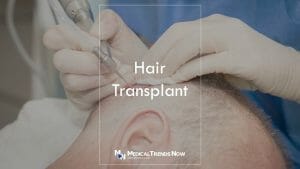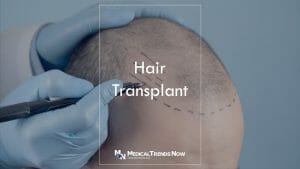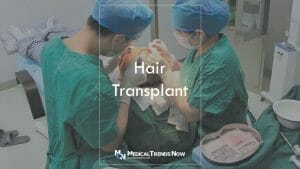Table of Contents
Hair transplant is a popular solution for hair loss, and the Philippines is becoming a popular destination for the procedure. The country has a large population of balding men, and many are turning to hair transplants. This is why hair transplants are popular in the Philippines.
New hope for balding Filipinos has arrived in the form of hair transplants. For years, Filipino men (and women) suffering from hair loss have had few options available to them. But with the advent of hair transplant surgery, there is now a way to restore one’s lost hair and regain confidence.
The good news is that hair transplants are now available in the Philippines and are more affordable than ever before. The procedure is relatively simple and involves taking hair follicles from the back of the head and transplanting them to the balding areas.
What Is Hair Transplant in the Philippines?
A hair transplant in the Philippines is a procedure that removes hair follicles from one part of the body, called the donor site, to a bald or balding part of the body, known as the recipient site.
Hair transplantation can be used to treat male pattern baldness. In this type of hair loss, grafts containing hair follicles that are genetically resistant to balding are transplanted to the bald scalp. This treatment can also restore eyelashes and eyebrows and fill in areas where hair has been lost due to trauma or surgery.
A hair transplant is a surgical procedure (but minimally invasive) that requires no stitches and leaves no scars. It is performed under local anesthesia that involves a scalpel or needle and takes about 4 to 8 hours, depending on the number of grafts transplanted. The top hair restoration is performed as an outpatient procedure, and Filipino patients can return to work the next day. Assuming that you can wear a cap or hat at work. The newly transplanted hair will start falling out 2-3 weeks after the procedure but will regrow within 6-9 months.

Who Should Visit Hair Transplant Clinic in the Philippines?
A hair transplant is an option for people who suffer from pattern baldness and have healthy existing hair on other parts of their head. Who are the good candidates for hair transplants? Well, the surgery is not suitable for every Filipino, though, and there are certain criteria that need to be met in order for a person to be eligible for the procedure. Below are the most common requirements for a patient to undergo a hair transplant in the Philippines.
- The area of baldness is at least 1.5 cm in diameter.
- The patient must have at least 2,500 grafts or more to make a noticeable difference.
- The patient must be at least 18 years old.
The Process Of A Hair Transplant: Hair Restoration Procedure
Hair transplantation is a procedure that takes hair from one area of the head and transplants it to another area. The procedure is usually performed on men who are balding or have thinning hair.
There are two types of hair transplant procedures: follicular unit transplantation and follicular unit extraction.

Follicular Unit Transplantation (FUT Hair)
In follicular unit transplantation, the surgeon removes a strip of skin from the back of the head and then dissects it into small units containing one to four hairs. The surgeon then makes tiny incisions in the balding area of the head and transplants the units of hair into these incisions.
Follicular Unit Extraction (FUE Hair Transplant)
Follicular unit extraction is a newer type of hair transplant procedure that does not require the removal of a strip of skin from the back of the head. Instead, the surgeon uses a special instrument to punch out small circles of tissue from the donor area.

Hair Transplant Procedure in the Philippines
A hair transplant in the Philippines is a popular procedure that helps people restore their hair. The procedure is performed by taking hair from the back of the head and transplanting it to the front. It is typically performed by taking hair from the back of the head and transplanting it to the bald or thinning areas. This can help create a natural-looking hairline and restore confidence. The procedure is usually performed under local anesthesia, which means that you will be awake during the surgery but will not feel any pain. The surgery itself takes about 4 hours, and you can expect to see results within 6-12 months.
Hair transplants are usually done under local anesthesia with sedation, meaning you’ll be awake but won’t feel any pain. The procedure takes about four to eight hours, depending on how much hair is being transplanted. You may need a second surgery if you want more hair transplanted.
Hair transplants can be used to restore eyelashes, eyebrows, and beard hair as well.
The Prices Of The Best Clinics: How Much Does A Hair Transplant Cost In The Philippines?
A hair transplant in the Philippines can cost anywhere from PHP 55,000 to PHP 500,000. The price will largely depend on the type of procedure you undergo and the number of grafts that are required.
Follicular unit extraction (FUE) is a popular type of hair transplant in the Philippines. This involves taking individual hairs from a donor area and transplanting them to the balding or thinning areas. FUE is typically more expensive than other types of hair transplants, but it often yields better results.
The number of grafts that are required will also affect the cost of your hair transplant. If you need a large number of grafts, expect to pay on the higher end of the spectrum. However, if you only require a small number of grafts, your costs will be lower.

How Much Does A Hair Transplant Cost In Manila?
Here are some of the prices of hair transplants in Manila.
Asian Hair Restoration Center
- FUE – Follicular Unit Extraction price starts from PHP 125,000
Address: Unit 1804 One San Miguel Bldg., Shaw Blvrd. Cor., One San Miguel Ave., Pasig City
Contact: +63 917 580 1684
Beaufaces Cosmetic Surgery and Facial Center
- Hair Transplant (3 sessions) PHP 200,000 – PHP 300,000
Address: Unit 103, Dona Anita Building, E Rodriguez Avenue, Quezon City, Philippines
Contact: +63 2 431 9093
Cosmetic Surgery Philippines (Dr. Enrico Valera)
- Hair Transplant starts from PHP 80,000
Address: Room 911 North Tower CHBC, St. Luke’s Medical Center, Quezon City
Contact: +63 920 909 2631
DHI Philippines by Clinique de Paris
- Hair Transplant (DHI – Direct Hair Implantation) PHP 150,000 – PHP 500,000
- Hair Loss Treatment (PRP – Platelet Rich Plasma Therapy) PHP 15,000 – PHP 40,000
- Scalp Micropigmentation PHP 95,000 – PHP 145,000
Address: G/F Twin Cities Condominium, 110 Legazpi Street, Legaspi Village, Makati City, Philippines, Makati, Metro Manila, 1229
Contact: +63 2 8893 6175
Hair Infinity – The Medical City
- Hair Transplant from PHP 55,000 (Depending on the number of grafts to be transplanted.)
Address: Ortigas Avenue, Pasig City
Contact: +63 2 636 2839
Nu/Hart Hair Restoration Clinic
- Hair Transplant PHP 80,000 – PHP 300,000
Address: Unit 301 State condominium 1 186 Salcedo st. Legazpi Village, Makati City
Contact: +63 2 818 8008

The Benefits Of A Hair Transplant in Philippines
A hair transplant in the Philippines has a number of benefits.
First, the cost of a hair transplant in the Philippines is significantly lower than the cost of a hair transplant in other countries.
Second, the quality of care and results you can expect from a hair transplant in the Philippines are on par with what you would expect from a hair transplant in any other country.
Finally, there are a number of experienced and qualified surgeons who perform hair transplants in the Philippines.
What Are The Advantages of Hair Transplant In The Philippines?
Hair loss can be a difficult experience for anyone. It can be especially tough for those who have never had to deal with it before. Hair transplants can be a great option for those looking to regain their confidence. There are many advantages of hair transplant, including:
- A hair transplant can give you back your natural hairline.
-
You will no longer have to worry about balding or thinning hair.
-
Hair transplants are a permanent solution to hair loss.
-
Hair transplants are safe and effective.
-
There is no downtime associated with hair transplants.
-
You can expect natural-looking results from a hair transplant.

Are Results Permanent If A Filipino Undergo A Hair Transplantation in Manila?
Hair transplants are a popular way to combat hair loss, but are the results permanent? The short answer is yes, but there are some caveats.
First, it’s important to understand how a hair transplant works. Hair follicles are harvested from an area of the scalp where hair is still growing and then transplanted to the balding or thinning areas. The follicles take root and begin to grow new hair.
Second, hair transplants are most successful when they’re performed by a skilled surgeon. Make sure you do your research and find a reputable Filipino board-certified dermatology doctor who has experience with this type of procedure.
Third, while the results of a hair transplant are permanent, there’s no guarantee that all of the transplanted hairs will survive and grow.
The results are usually permanent, although some people may experience temporary shedding of transplanted hair. Side effects are uncommon but can include infection, scarring, and pain.

The Risks Of Follicular Unit Transplant and Follicular Unit Extraction
Hair transplants are becoming increasingly popular, but there are still risks involved. These risks can range from infection to scarring and even death in extremely rare cases. It’s important to weigh the risks and benefits of a hair transplant before making a decision.
Infection is one of the most common risks associated with hair transplants. This can happen at the donor site, where hair is taken from, or at the recipient site, where it is transplanted. Infection can cause swelling, redness, and pain. It can also lead to scarring and permanent damage to the hair follicles.
Scarring is another common risk of hair transplants. The surgeon may use a scalpel to remove strips of skin from the donor site. This can leave behind scars that are visible when the hair is shaved short. The transplant itself can also cause scarring.
Before you undergo a hair transplant, it’s important to understand the risks involved. Talk to a Filipino board-certified dermatology doctor about the potential for infection and what you can do to minimize your risk.

Different Types of Hair Transplant in the Philippines (FUT & FUE)
There are two main types of hair transplant procedures: follicular unit transplantation (FUT procedure) and follicular unit extraction (FUE procedure).
FUT is the traditional hair transplant method that involves removing a strip of skin from the donor site and dissecting it into individual grafts. The grafts are then transplanted to the recipient site.
FUE is a newer hair transplant technique that involves individually extracting hair follicles from the donor site and transplanting them to the recipient site. FUE is less invasive than FUT and leaves no linear scar.

What Is The Recovery Time After Visiting Hair Transplant Clinics In Philippines?
The recovery time for hair transplants in the Philippines can vary depending on the extent of the surgery and the individual’s healing process. However, most patients can expect to take approximately two weeks off from work or other activities. During this time, it is important to rest and avoid strenuous activity or sun exposure. After two weeks, patients can typically return to their normal routine with no restrictions.
Overall, hair transplant surgery is a relatively safe and effective treatment for male pattern baldness.
New Hope: Minimally Invasive Hair Transplants
A new hope for people with hair loss is on the horizon in the form of minimally invasive hair transplants. This new technique uses a small amount of the patient’s own hair to create natural results.
The traditional hair transplant method involves taking a large strip of hair from the back of the head and grafting it to the balding area. This can leave a noticeable scar, as well as cause pain and discomfort.
With the minimally invasive technique, only a small section of hair is taken from the donor area. This results in less pain and fewer side effects for the patient. It also leaves a smaller scar that is much less noticeable.
This new method is still in its early stages but shows great promise for those who are seeking an alternative to traditional hair transplants.

Where To Get A Hair Transplant In The Philippines (Transplant Clinic or Hospital)
The best way to find a hair restoration clinic that offers hair transplants in the Philippines is to search online. You can also ask your friends or family if they know of any good clinics. Once you have found a few clinics, you can compare prices and services to find the best one for you.
How to select the best hair transplant doctor?
When it comes to hair transplants, you want to make sure you select the best dermatology board-certified Filipino doctor possible. Here are a few tips on how to select the best hair transplant doctor in the Philippines:
1. Do your research
Make sure you read up on different hair transplant doctors and procedures.
2. Ask around
Talk to friends, family, and even your regular Filipino doctor for recommendations.
3. Consider your options
There are a variety of hair transplant procedures available, so be sure to discuss all of your options with a potential Filipino doctor.
4. Get a consultation
Once you’ve narrowed down your options, be sure to schedule a consultation with each potential doctor in the Philippines. This will give you a chance to ask questions and get more information about the procedure and the Filipino doctor’s experience level.
5. Make a decision
Once you’ve chosen a Pinoy doctor and procedure, be sure to make your decision as quickly as possible. Hair transplant procedures are relatively quick and inexpensive in the Philippines.

FAQ About Hairloss And Baldness
Here are some of the most frequently asked questions about hair loss and baldness in the Philippines.
What Is Hair Loss Problem? What Are The Hair Loss Solutions?
Hair loss and baldness can refer to the medical condition alopecia, which can have many causes. Alopecia can be genetic, caused by hormones, or a result of certain medical conditions or medications. It can also be due to physical or emotional stress. Hair loss can occur on the scalp, face, and other parts of the body. Baldness is when there is complete hair loss on the scalp.

Causes Of Hair Loss And Baldness
When hair growth stops, and the amount of hair falls in enormous numbers, then it is time to reconsider hair restoration surgery. Hair loss and baldness can be caused by a variety of factors. Heredity plays a big role in both hair loss and baldness. If your parents or grandparents are bald, you are more likely to experience hair loss or baldness as well. It’s time for a Filipino patient to visit a hair restoration center to check the hair and scalp symptoms. Other causes of hair loss and baldness include:
- Certain medical conditions: Cancer, alopecia, lupus, thyroid problems, and anemia can all cause hair loss.
- Certain medications: Chemotherapy drugs, blood thinners, beta-blockers, and birth control pills can cause hair loss.
- Stress: Physical or emotional stress can cause hair thinning or shedding.
- Hormonal changes: Pregnancy, menopause, and puberty can all lead to temporary hair loss.
Hair loss and baldness can be caused by many different things. It can be a result of genetics, illness, medications, or even stress. Whatever the cause, it can be frustrating and even embarrassing.
There are many different new treatments available for hair loss and baldness, depending on the cause. If it is due to genetics, there is not much that can be done. However, if the hair loss is due to an illness or medication, there may be options to try. Stress-related hair loss is often temporary and can be treated with relaxation techniques or changes in diet and lifestyle.
If you are experiencing hair loss or baldness, talk to your hair transplant surgeon doctor in the Philippines to find out what might be causing it and what hair transplant and restoration treatment options are available.

Hair Loss And Baldness In Filipino Men
Hair loss and baldness in men is a very common problem among Filipino men. There are many different causes of permanent hair loss, such as genetics, age, stress, medications, and medical conditions. Many men experience some degree of hair loss as they age. However, it can be a very distressing problem for some men and can affect their self-esteem and confidence. There are advanced hair restoration services and treatments available that can help to improve the appearance of hair loss and slow down the progression of baldness.
Hair Loss And Baldness In Filipino Women
Hair loss and baldness are not just problems for men. Filipino women can suffer from hair loss and baldness, too. While it is less common in women than in men, it can be just as devastating to a woman’s self-esteem.
There are many causes of hair loss in women, including medical conditions, such as thyroid disease and anemia, certain medications, and stress. If you are experiencing hair loss, see your leading hair transplant Filipino doctor and find out the cause and get treatment.
There are several non-surgical methods used for hair loss in women, including minoxidil (Rogaine), which is a topical medication that is applied to the scalp to keep your hair healthy; finasteride (Propecia), a pill taken by mouth; and low-level laser therapy.

Hair Loss Solutions And Baldness Treatments
Hair thinning or balding can be treated with a variety of methods. The most common method is medication. There are many different types of medications that can be used to treat hair loss and baldness. Some of these medications include minoxidil, finasteride, and dutasteride.
Another common treatment for hair loss and baldness is surgery. Hair implant or hair transplantation involves surgery. It is a popular option for many Filipinos. Hair transplantation surgery involves taking hair from one area of the head (or surrounding hair) and transplanting it to the bald or thinning areas of the patients hair. This surgery can be very effective in treating hair loss and baldness.
There are also a number of home remedies that can be used to treat hair loss and baldness. These home remedies include using essential oils, aloe vera, and green tea.

What is Graft in Hair Loss Treatment?
Filipinos who may experience hair loss will have a restoration treatment, which typically involves the use of grafts. Hair graft is a small piece of skin that contains individual hair follicles. The graft is removed from an area of the scalp where hair is thick and transplanted to an area where hair is thin or missing.
Grafting is often used to treat male pattern baldness. In this condition, hair follicles are sensitive to a hormone called dihydrotestosterone (DHT). DHT causes the follicles to miniaturize, resulting in thinner and shorter hairs. Over time, the follicles may stop producing hairs altogether.

Prevention Of Hair Loss And Baldness in the Philippines
Hair loss and baldness are common problems that affect not only Filipinos but millions of people around the world. While there is no cure for these conditions, there are several ways to prevent them from occurring.
One of the best ways to prevent hair loss and baldness is to keep your scalp healthy. A healthy scalp is one that is free of dandruff, dryness, and inflammation. You can keep your scalp healthy by using a mild shampoo and conditioner, avoiding harsh chemicals and heat styling, and massaging your scalp regularly.
Another way to prevent hair loss and baldness is to avoid damaging your hair. Damage can be caused by over-processing, heat styling, and using harsh chemicals. To avoid damage, use low-heat styling methods, air dry your hair whenever possible, and use gentle products that are designed for fragile hair.

Takeaway: Hair Transplant in the Philippines
The procedure of hair transplant in the Philippines is relatively affordable, and there are a number of clinics that offer the procedure. There are some risks associated with hair transplant, but overall it is a safe and effective way to treat hair loss among Filipinos.

Sources: Hair Transplant in the Philippines
- Hair Transplant Clinic in The Philippines | Svenson
- DHI Philippines: Best Hair Transplant Clinic
- FUE & FUT Hair Transplant – Hair Restoration Philippines
- Hair Transplant Philippines: Candidates, Procedures & Result
- Hair Transplant Cost in Manila | Top Hair Restoration Services
- Average Cost of Hair Transplant in the Philippines – NU/HART
- Hair Restoration and Transplant Manila Philippines | Asian Hair Restoration Center
- Hair transplant surgery – Better Health Channel
- Hair Transplant: How Does It Work, Success Rates
- Hair transplant – Cosmetic procedures – NHS
- A hair transplant can give you permanent, natural-looking results – American Academy of Dermatology Association
- Hair Transplantation and Restoration | American Society of Plastic Surgeons ASPS
- Hair Transplantation Frequently Asked Questions – The University of Pennsylvania, Penn Medicine
- Hair Transplantation – StatPearls – NCBI Bookshelf
- Hair Transplant | Johns Hopkins Medicine

Disclaimer: Hair Transplant in the Philippines
This website is intended to educate both members of the general public and those working in the medical field on the prevalence, causes, and methods for preventing, diagnosing and treating diseases that affect people throughout their lives. This website’s content is provided solely for informational reasons and is not meant to serve as a substitute for the advice of a qualified medical practitioner.













